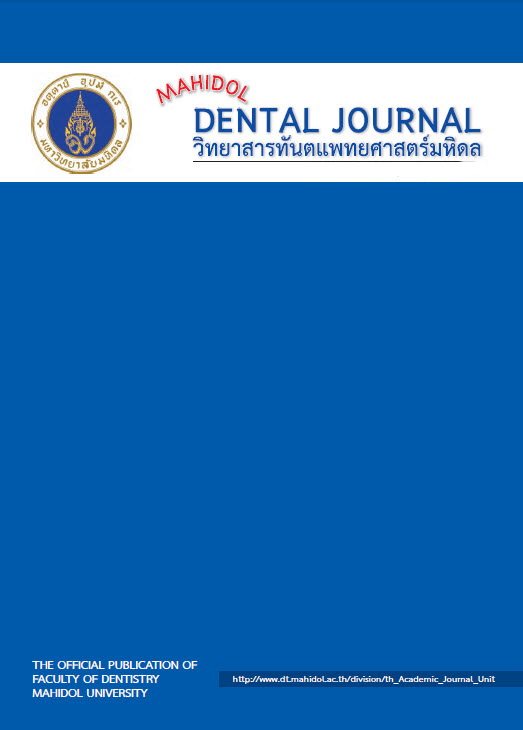Effect of Resin Infusion on Fracture Toughness of Dental Veneering Ceramic
Main Article Content
Abstract
Objective: The objective of this study was to investigate effect of resin infusion on fracture toughness of dental veneering ceramic (IPS e.max Ceram®).
Materials and methods: Ten bars, size 2 x 4 x 24 mm of veneering ceramic as a control were prepared following the manufacturer’s recommendation. The other ten experimental bars of resin-infused veneering ceramic were prepared by initially mixing the ceramic powder with polymeric fiber (0.1 % by mass), pressed into the mold and then firing according to the firing schedule without vacuum. After firing, a mixture of urethane resin was infused into the specimens under vacuum at 1x10-2 Torr for 6 hours and cured by dry heat at 100°C for 6 hours. Vickers hardness tester was used to create pre-crack indentation on the specimen. Four-point bending test was performed using a universal testing machine with a crosshead speed of 0.5 mm/min until fracture. Fracture surfaces of all specimens were examined under optical light microscope. Critical flaw sizes were measured using the fractographic analysis approach. Fracture toughness (KIc) was calculated. Independent sample t-test was used to determine significant difference of the mean KIc between control group and experimental resin-infused ceramic group at α = 0.05.
Results: The mean KIc of resin-infused ceramic (0.75 ± 0.06 MPa•m1/2) was statistically greater than that of control group (0.69 ± 0.07 MPa•m1/2), (p = 0.03).
Conclusion: Resin-infusion had significant influence on fracture toughness of veneering ceramic.
Article Details
References
2. Guess PC, Zhang Y, Thompson VP. Effect of veneering techniques on damage and reliability of Y-TZP trilayers. Eur J Esthet Dent. 2009; 4: 262-76.
3. Scherrer SS, Denry IL, Wiskott HW. Comparison of three fracture toughness testing techniques using a dental glass and a dental ceramic. Dent Mater. 1998; 14: 246-55.
4. Xu HH, Martin TA, Antonucci JM, Eichmiller FC. Ceramic whisker reinforcement of dental resin composites. J Dent Res. 1999; 78: 706-12.
5. Xu HH. Dental composite resins containing silica-fused ceramic single-crystalline whiskers with various filler levels. J Dent Res. 1999; 78: 1304-11.
6. Chaiyabutr Y, Giordano R, Pober R. The effect of different powder particle size on mechanical properties of sintered alumina, resin- and glass-infused alumina. J Biomed Mater Res B Appl Biomater. 2009; 88: 502-8.
7. Coldea A, Swain MV, Thiel N. Mechanical properties of polymer-infiltrated-ceramic-network materials. Dent Mater. 2013; 29: 419-26.
8. Mecholsky JJ Jr. Quantitative fractography: an assessment. In: Alfred NY, Varner JR, Fréchette VD, Quinn GD, editors. Fractography of glasses and ceramics; Proceedings of the conference on the fractography of glasses and ceramics; August 3-6, 1986; Westerville OH: American Ceramic Society; 1991. pp. 413-51.
9. Taskonak B, Mecholsky JJ Jr, Anusavice KJ. Fracture surface analysis of clinically failed fixed partial dentures. J Dent Res. 2006; 85: 277-81.
10. Clarke DR. Interpenetrating Phase Composites. J Am Ceram Soc. 1992; 75: 739-58.
11. Scherrer SS, Kelly JR, Quinn GD, Xu K. Fracture toughness (KIc) of a dental porcelain determined by fractographic analysis. Dent Mater. 1999; 15: 342-8.
12. Wang H, Pallav P, Isgrò G, Feilzer AJ. Fracture toughness comparison of three test methods with four dental porcelains. Dent Mater. 2007; 23: 905-10.
13. Oh WS, Park JM, Anusavice K. Fracture toughness (KIc) of a hot-pressed core ceramic based on fractographic analysis of fractured ceramic FPDs. Int J Prosthodont. 2003; 16: 135-40.
14. Schmitt J, Wichmann M, Holst S, Reich S. Restoring severely compromised anterior teeth with zirconia crowns and feather-edged margin preparations: a 3-year follow-up of a prospective clinical trial. Int J Prosthodont. 2010; 23: 107-9.
15. Beuer F, Stimmelmayr M, Gernet W, Edelhoff D, Güh JF, Naumann M. Prospective study of zirconia-based restorations: 3-year clinical results. Quintessence International. 2010; 41: 631-7.
16. Sailer I, Gottnerb J, Kanelb S, Hammerle CH. Randomized controlled clinical trial of zirconia-ceramic and metal-ceramic posterior fixed dental prostheses: a 3-year follow-up. Int J Prosthodont. 2009; 22: 553-60.
17. Roediger M, Gersdorff N, Huels A, Rinke S. Prospective evaluation of zirconia posterior fixed partial dentures: four-year clinical results. Int J Prosthodont. 2010; 23: 141-8.
18. Larsson C, Vult von Steyern P, Nilner K. A prospective study of implant-supported full-arch yttria-stabilized tetragonal zirconia polycrystal mandibular fixed dental prostheses: three-year results. Int J Prosthodont. 2010; 23: 364-9.
19. Lange FF, Velamakanni VB, Evans AG. Method for Processing Metal-Reinforced Ceramic Composites. J Am Ceram Soc. 1990; 73: 388-93.
20. Ruddell DE, Maloney MM, Thompson JY. Effect of novel filler particles on the mechanical and wear properties of dental composites. Dent Mater. 2002; 18: 72-80.


